Targeted Lipid Quantification
Absolute quantification of defined lipid panels, including ceramides, eicosanoids, sphingomyelins, and neuroactive lipid mediators.
Our services have earned the trust of companies, schools, and organizations globally, and we remain dedicated to maintaining that trust.
The brain is one of the most lipid-rich organs in the human body, with lipids accounting for more than 50% of its dry weight. These biomolecules are not only fundamental to the structural integrity of neural membranes and myelin sheaths, but also function as signaling mediators, energy substrates, and modulators of neuroinflammation and synaptic plasticity.
Unlike peripheral tissues, the brain features a uniquely complex and dynamic lipidome shaped by regional specialization, blood-brain barrier regulation, and neuro-glial interactions. This makes the brain an exceptionally informative sample type for lipidomics studies aiming to:
Using brain tissue as the analytical starting point enables researchers to directly profile the lipid pathways underpinning central nervous system physiology and pathology, providing greater mechanistic insight than surrogate matrices.
Brain lipidomics is a high-value analytical approach when your research or clinical questions involve the central nervous system.
| Application Area | Purpose of Brain Lipidomics |
|---|---|
| Neurodegenerative Disease Research | Detect disease-stage-specific changes in sphingolipids, ceramides, gangliosides |
| Neuroinflammation and Immunometabolism | Quantify lipid mediators like prostaglandins, resolvins, and endocannabinoids |
| Brain Energy Metabolism Studies | Assess shifts in acylcarnitines, glycerolipids, and fatty acids |
| Developmental and Pediatric Neuroscience | Track lipid remodeling during brain maturation, synaptogenesis, and myelination |
| Ischemia, TBI, or Stroke Models | Map region-specific lipid degradation, oxidation, and recovery trajectories |
| Psychiatric and Behavioral Studies | Link lipid dysregulation to neurotransmitter imbalances or cognitive phenotypes |
| Neuropharmacology and Toxicology | Evaluate lipid-based biomarkers of neurotoxicity, neuroprotection, or drug efficacy |
By targeting brain-derived lipid profiles, researchers can achieve unparalleled resolution in understanding CNS-specific biochemical changes that are often masked or diluted in systemic samples like blood or urine.

Targeted Lipid Quantification
Absolute quantification of defined lipid panels, including ceramides, eicosanoids, sphingomyelins, and neuroactive lipid mediators.

Untargeted Brain Lipidomics
Comprehensive profiling of brain lipids using high-resolution LC-MS/MS to discover novel lipid species and pathway alterations.

Lipid Transport & Metabolism Profiling
Quantitative analysis of lipids involved in transport, storage, and metabolic fluxes—such as acylcarnitines, monoacylglycerols, and sterol derivatives—to support studies on brain energy dynamics and lipid trafficking.

Neuro-Lipid Mediator Profiling
Focused analysis of bioactive lipids involved in neuroinflammation, synaptic function, and endocannabinoid signaling.

Subcellular Lipidomics
Profiling of lipids within isolated synaptosomes, mitochondria, or nuclear fractions to support organelle-specific studies.

Microbiome–Brain Lipidomics Integration
Multi-omics service integrating lipidomics with gut microbiome sequencing to explore the gut-brain axis.

Spatial Lipidomics (Optional)
Mass spectrometry imaging or laser capture microdissection (LCM)-based lipidomics preserving anatomical localization.

Custom Lipidomics Development
Tailored method development for rare lipid species, unique brain models, or specific analytical challenges.
| Lipid Subclass | Representative Species | Related Metabolites | Key Pathways |
|---|---|---|---|
| Phosphatidylcholine (PC) | PC 16:0/18:1, PC 18:0/20:4 | Lyso-PC, Choline | Glycerophospholipid metabolism, membrane fluidity |
| Phosphatidylethanolamine (PE) | PE 18:1/18:2, PE 16:0/22:6 | Lyso-PE, Ethanolamine | Membrane remodeling, autophagy |
| Phosphatidylserine (PS) | PS 18:0/18:1 | Serine | Apoptosis signaling |
| Phosphatidylinositol (PI) | PI 18:0/20:4 | Inositol | PI cycle, intracellular signaling |
| Phosphatidic Acid (PA) | PA 16:0/18:1 | G3P | Lipid biosynthesis |
| Cardiolipin (CL) | CL 72:8, CL 70:6 | PG, G3P | Mitochondrial function, apoptosis |
| Plasmalogens (PlsEtn/PlsCho) | PlsEtn 16:0/22:6, PlsCho 18:0/20:4 | Aldehyde derivatives | Antioxidant defense, neural membrane structure |
| Lipid Subclass | Representative Species | Related Metabolites | Key Pathways |
|---|---|---|---|
| Ceramides (Cer) | Cer d18:1/24:0, Cer d18:1/16:0 | Sphingosine | Apoptosis, insulin resistance |
| Sphingomyelins (SM) | SM d18:1/16:0, SM d18:1/24:1 | Choline | Myelin sheath structure, cell signaling |
| Hexosylceramides (HexCer) | GluCer, GalCer | Glucose, Galactose | Glycosphingolipid metabolism |
| Lactosylceramides (LacCer) | LacCer d18:1/24:1 | UDP-Gal, Glucose | Inflammatory signaling |
| Sphingosine-1-Phosphate (S1P) | — | S1P | Immune modulation, vascular tone |
| Sulfatides | ST 18:1/24:0 | GalCer-SO3 | Myelin compaction, oligodendrocyte function |
| GM Gangliosides (GM1, GM2, etc.) | GM1 18:1/24:1, GM3 18:0/20:0 | NANA (sialic acid), UDP-sugars | Neurodevelopment, synaptic plasticity |
| Lipid Subclass | Representative Species | Related Metabolites | Key Pathways |
|---|---|---|---|
| Triacylglycerols (TAG) | TG 16:0/18:1/18:2, TG 18:1/18:1/18:1 | Glycerol, Free fatty acids | Lipogenesis, energy storage |
| Diacylglycerols (DAG) | DG 18:1/18:2, DG 16:0/18:1 | Glycerol, DAG | Lipid signaling, PKC activation |
| Monoacylglycerols (MG) | MG 18:1, MG 16:0 | Glycerol | Lipolysis, endocannabinoid metabolism |
| Alkylacylglycerols (Ether lipids) | AG 16:0/20:4 | Ether-linked FAs | Neuronal membrane integrity, oxidative protection |
| Lipid/Metabolite | Representative Species | Related Metabolites | Key Pathways |
|---|---|---|---|
| Free Fatty Acids (FFA) | Palmitate (16:0), Oleate (18:1), Arachidonate (20:4) | Acetyl-CoA | β-oxidation, fatty acid synthesis |
| Acylcarnitines | C2, C4, C16, C18:1, C18:2 | L-carnitine, CoA | Mitochondrial transport, energy homeostasis |
| Oxidized Fatty Acids | HODEs, HETEs, EETs, EpOMEs | LOX/CYP-derived species | Neuroinflammation, oxidative stress response |
| Lipid Subclass | Representative Species | Related Metabolites | Key Pathways |
|---|---|---|---|
| Cholesterol | Free cholesterol | Lanosterol, Desmosterol | Steroid biosynthesis, synapse formation |
| Cholesteryl Esters (CE) | CE 18:1, CE 20:4 | Cholesterol | Lipoprotein metabolism, storage |
| Oxysterols | 7-Ketocholesterol, 24S-Hydroxycholesterol | Bile acids, ROS derivatives | Oxidative signaling, bile acid synthesis |
| Neurosteroids | Pregnenolone, Allopregnanolone | Progesterone | GABAergic modulation, neuroprotection |
| Lipid Subclass | Representative Species | Related Metabolites | Key Pathways |
|---|---|---|---|
| Endocannabinoids | Anandamide (AEA), 2-AG | Ethanolamine, Glycerol | ECS signaling, mood regulation |
| Prostaglandins | PGD2, PGE2, PGF2α | Arachidonic acid | Inflammatory response, fever, pain |
| Specialized Pro-resolving Mediators (SPMs) | Resolvin D1, Protectin D1, Maresin 1 | DHA, EPA | Inflammation resolution, tissue repair |
| Leukotrienes | LTB4, LTC4 | 5-HPETE | Immune cell activation |
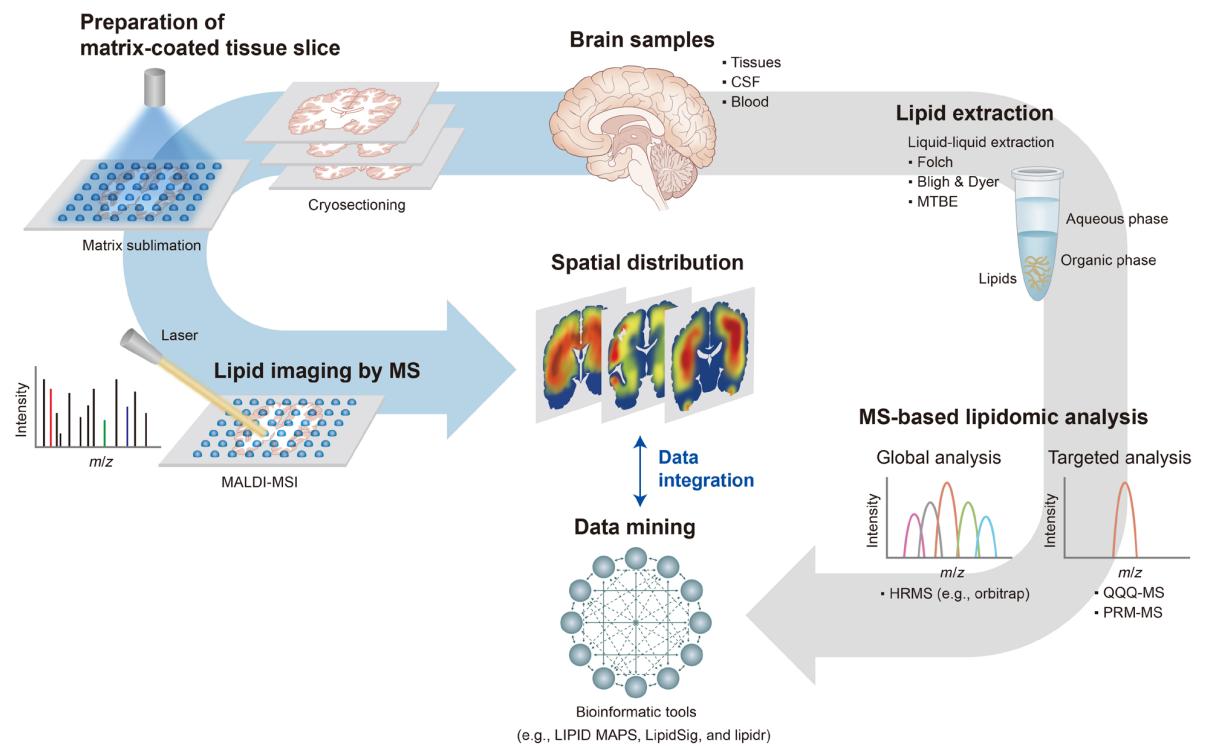 MS-based analytical strategy for brain lipidomics research (Yoon, Jong Hyuk, et al., 2022).
MS-based analytical strategy for brain lipidomics research (Yoon, Jong Hyuk, et al., 2022).
UHPLC–Q Exactive Plus (Thermo Fisher Scientific): High-resolution Orbitrap platform ideal for untargeted lipid profiling with accurate mass detection and in-depth MS/MS fragmentation.
Agilent 6495C Triple Quadrupole LC-MS/MS: Ultra-sensitive triple quadrupole system with femtogram-level detection, ideal for targeted quantification of specific lipid species in brain tissue or cerebrospinal fluid.
TSQ Altis Triple Quadrupole (Thermo Fisher Scientific): A robust and precise platform for high-throughput, targeted lipid quantification with broad dynamic range and excellent inter-assay consistency.
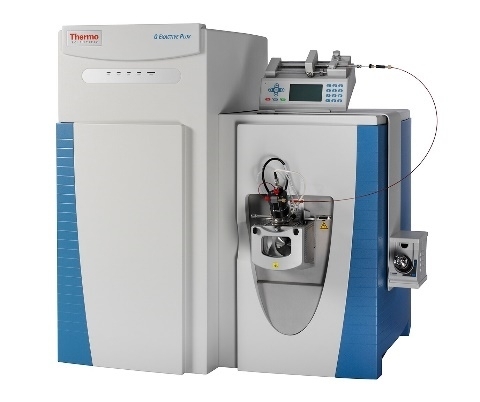
Thermo Fisher Q Exactive (Orbitrap LC-MS/MS) (Figure from Thermo Fisher)
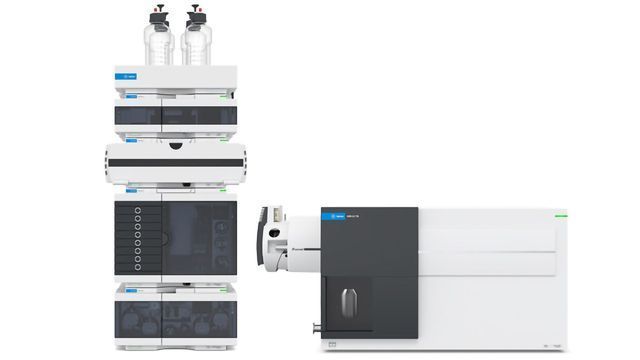
Agilent 6495C + 1260 HPLC (Figure from Agilent)
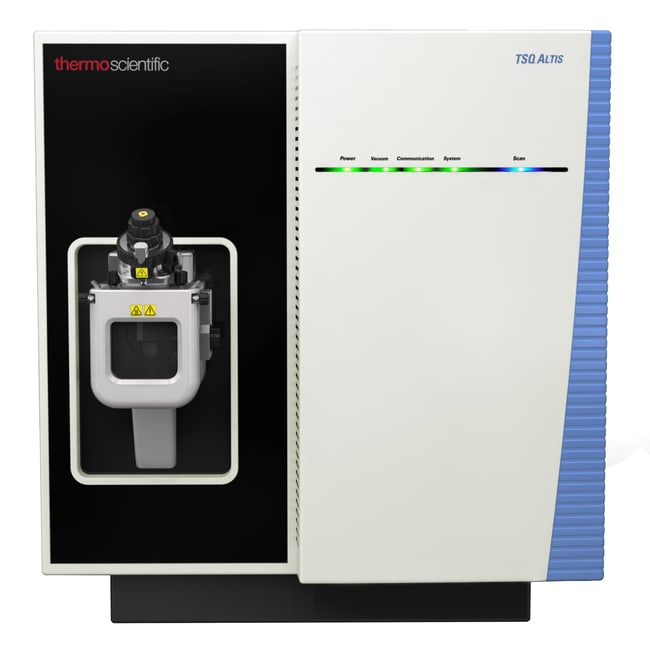
TSQ Altis Triple Quadrupole (Figure from Thermo Fisher)
Differential analysis:
Multivariate analysis:
Pathway enrichment:
Comprehensive data report including:
Expert summary with key findings and suggested next steps
Explore our Lipidomics Solutions brochure to learn more about our comprehensive lipidomics analysis platform.

| Sample Type | Recommended Amount | Notes |
|---|---|---|
| Brain Tissue (fresh/frozen) | ≥ 50 mg | Snap-frozen in liquid nitrogen; avoid thawing |
| Cerebrospinal Fluid (CSF) | ≥ 200 µL | Collected in sterile, lipid-free tubes |
| Serum / Plasma | ≥ 100 µL | EDTA or heparin anticoagulants preferred |
| Cultured Cells | ≥ 1 × 10⁷ cells | Washed with PBS, stored at -80°C |
| Organoids / Brain Slices | Equivalent to ≥ 50 mg tissue | Ensure sample integrity and minimal handling |

Neuroscience Research
Elucidates lipid signaling roles in synaptic plasticity, neurogenesis, and brain development.

Aging Research
Tracks lipid composition changes associated with brain aging and cognitive decline.

Nutritional Neuroscience
Assesses dietary lipid effects (e.g., omega-3 PUFA) on brain lipid homeostasis.

Environmental Toxicology
Evaluates neurotoxic effects of pollutants or chemicals via lipid profile alterations.

Pharmacological Mechanism Studies
Monitors brain lipid changes in response to neuroactive compound exposure.

Animal Model Validation
Characterizes lipidomic phenotypes in transgenic or chemically induced brain disorder models.
Can I submit different types of brain samples within the same project?
Yes. We can analyze mixed sample types (e.g., tissue, CSF, plasma) in the same project, provided each sample meets the quantity and storage requirements. Please contact us in advance to optimize experimental design and extraction protocols.
How do you handle low-yield or limited samples?
For scarce samples (e.g., microdissected brain regions), we offer modified extraction protocols and sensitive quantification workflows using triple quadrupole instruments to maximize lipid recovery and detection.
Can I provide my own internal standards?
Yes. You may supply custom internal standards, and we will integrate them into the extraction and quantification process. Please provide standard concentration and chemical details for compatibility.
Do you provide assistance with study design or statistical planning?
Absolutely. Our scientific support team offers free consultation on sample grouping, statistical power estimation, and biological replicates to ensure robust, publication-ready results.
Can you help interpret results if I'm not a lipidomics specialist?
Yes. All projects include expert annotations, biological pathway mapping, and a summary written for both technical and non-technical users. We also provide follow-up meetings upon request.
What data formats do you deliver?
We provide results in Excel (.xlsx), raw data files (.raw/.mzML), statistical output files (.csv/.pdf), and image files for figures (e.g., .png, .svg). Custom formats (e.g., for MetaboAnalyst or Cytoscape) are available on request.
Is it possible to re-analyze data later with updated targets or pathways?
Yes. We archive raw and processed data securely and can reprocess or re-annotate datasets with new lipid targets, updated databases, or additional statistical models upon request.
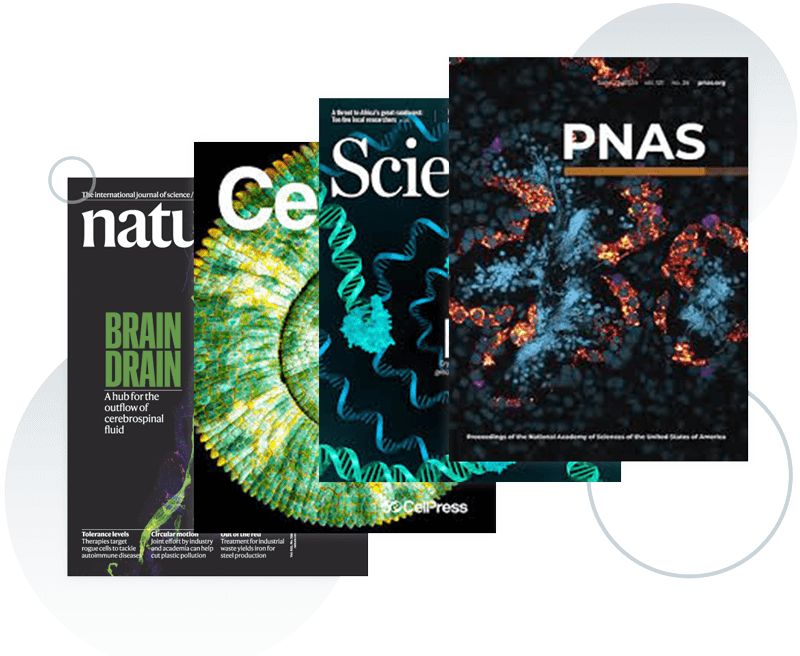
References
Services:
Online Inquiry
CONTACT US

